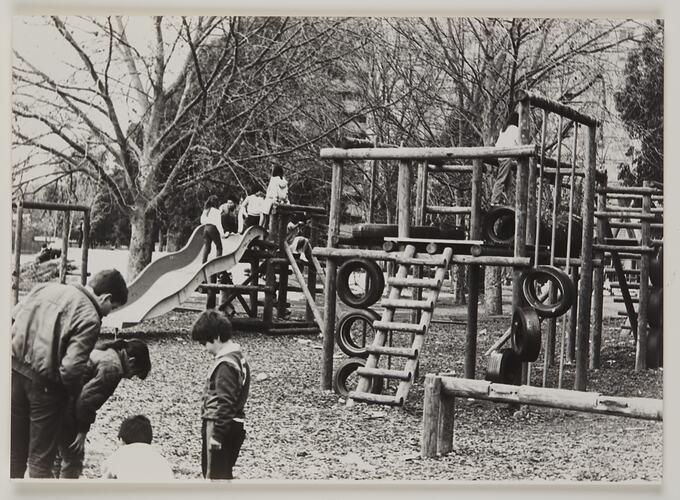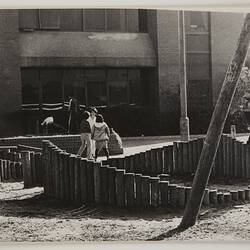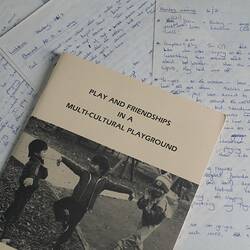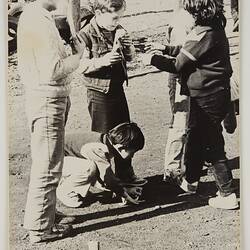In 1984 June Factor and Gwenda Davey initiated a study to observe and document the play activities of children in a multi-cultural primary school in Melbourne, Victoria. 'Play & Friendships in a Multi-Cultural Playground' was made possible through the support of the Research Centre of the Institute of Early Childhood Development and the Human Rights Commission. The study researcher was Heather Russell and the photographer was Tess Guggenheimer.
Most of the children in the inner suburban primary school came from non-English speaking backgrounds and lived in a nearby high-rise public housing complex. Many children went home for lunch every day so at most, about 200 of the 342 children who attended the school were in the playground at lunchtime.
Playground observations took place in two stages: one period of 20 days over a four-week period and a second period of 12 days over five weeks. A subsequent interview program conducted by Russell involved 46 children, seeking more specific information about their play, games, folkloric activities and friendships. Every effort was made to ensure a diverse cultural mix that took into account gender and age differences.
The school had a high number of newly arrived Indochinese children, many of whom had a disrupted early education, sometimes in refugee camps. Each year level could vary in age up to three years. A minority of children spoke English at home and the majority (55%) were from families where the main breadwinner was unemployed or receiving welfare benefits. The play areas at the school were not ideal and there was a reliance on surrounding public space to augment them. Even so, girls who wanted to play ball games such as netball were not accommodated. No netball court existed. Girls who were interested in playing ball games played cricket or football instead.
Gender, age and cultural background all contributed to the interesting study findings. In general, girls were more likely to engage in traditional rule-bound games than boys and to play in smaller and more homogenous cultural groups. Boys were more likely to play in larger, more multi-cultural groups due to the nature of their preferred play (football and soccer).
Furthermore, games that may have been played in Indochinese schools by both girls and boys, such as high jump, were rarely played by boys here due to different understandings of what constituted girls' and boys' play. 'It seems that male-female divisions in playground games are strongly marked in Australia and that this is very quickly picked up by immigrant children', observed Russell.
Russell made several important recommendations based on the findings of the study:
1. Primary schools should provide playground space which is appropriate to the play requirements of children of different ages. Privacy and security are important factors to consider.
2. Children's traditional games should be encouraged in the playground because they are challenging and involve the development of important physical skills. They are also an acceptable expression of children's cultural diversity and a means of cultural interchange. (Boys playing marbles adopted flicking styles of children from different ethnic backgrounds, for example.)
3. Children from different ethnic backgrounds should be encouraged to engage in folkloric play. Those children who, for whatever reason, do not know any traditional games should be assisted to learn games and verbal lore from their own cultural background, as well as games that are in vogue in their own play environment.
4. Children need to be exposed to traditional rhymes and songs in the English language that can be used during play, such as skipping rhymes. Verbal lore is an excellent way of introducing children to a new language.
5. Playground equipment should be challenging and provide a wide range of opportunities for a wide range of children. It provides opportunities for group interaction.
The study findings were published as Play and Friendships in a Multi-Cultural Playground, authored by Heather Russell (assisted by Gwenda Davey and June Factor), Australian Children's Folklore Publications, Institute of Early Childhood Development, Melbourne, 1986. The publication, fieldwork notes, recordings and photographs are held by Museums Victoria, within the Australian Children's Folklore Collection archive HT 8469, ACFC Series 4, Play & Friendships in a Multi-Cultural Playground, 1984. The archive comprises 29 audio tapes, containing interviews with 46 children; 84 photographs; four videotapes of compiled footage; data observation sheets of playground activity; and data sheets containing written descriptions of games.
More Information
-
Keywords
-
Localities
-
Authors
-
Article types





